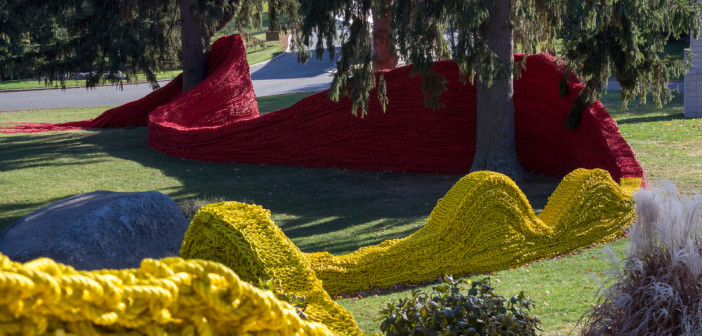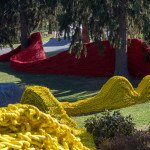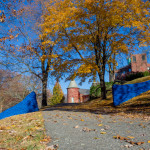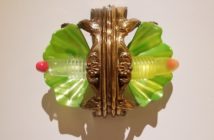Orly Genger’s Red, Yellow and Blue, a monumental installation of hand-knotted rope, was recently moved from its summer home at Madison Square Park in New York City and reinstalled at deCordova Sculpture Park and Museum, where it will remain until next September. I saw the work in both locations — in New York where its alarmingly bright primary colors popped against the lush greens of the picturesque park gardens, and more recently at deCordova where the sculpture provides a much-needed infusion of color and vibrancy against the gray November skies.
Genger’s most ambitious works to date, Red, Yellow and Blue is comprised of 1.4 million feet of repurposed lobster-fishing rope, and weighs over 50 tons. Genger incorporates her well-known practice of weaving rope in sections, spray painting the rope bright colors, and stacking and configuring the sections into large organic-looking forms. All of Genger’s works are hand-made, and the knotting process is not sped up with the use of machines or technology. Though Genger works with several assistants, almost every foot of rope passes through her hands; either in the studio where she knots the rope, or on site, where the work takes its sculptural form. The process of creating Red, Yellow and Blue took over two years and when viewing the seemingly endless walls of rope, one cannot help but contemplate the artist obsessively pouring over countless piles of material for this labor-intensive work.
Labor is conspicuous in Genger’s work. Viewers can see each knot, and each one represents an individual action by the artist. As Genger notes, her works are "a physical manifestation of time." In this way, Red Yellow and Blue is performative, as it records the artistic gesture. Much like a splash of paint on a Pollock canvas, each of Genger’s rope knots represents an individual action. Though these repeated actions, throwing paint or knotting rope, are similar in conception, each movement is executed differently and results in a distinctive record of a moment in time. With many thousands of unique knots, the body and action of the artist in Red, Yellow and Blue is constantly visible.
This close connection between artist and material in Red, Yellow and Blue separates Genger from the Minimalist sculpture tradition. Though often compared to the work of artists such as Tony Smith and Richard Serra because of a shared use of exaggerated scale and abstract form, Genger’s work stands apart because of a use of soft materials manipulated into organic shapes by her hands directly. The uses of traditionally Minimalist materials, such as sleek steel and industrial concrete, which are endlessly recreated with machinery, contrast with Genger’s works. Her sculptures feature the quirks and eccentricities of the hand-made, making the work more approachable and human.
According to Genger, the most creative part of her work is the installation. The rope sections are building blocks for Genger to create intricate, bodily sculptural forms. Each piece is constructed, and this modularity gives Genger a flexibility not available to many artists. As a result, the installation takes on new life as it takes a different shape. Being installed at two sites, Red, Yellow and Blue has taken on two unique iterations. At the Madison Square Park site, the installation was separated into three sections of the park, one for each color. The rope was stacked high, over twenty feet in some places, and created distinct enclosures. At points the rope was stacked so high it blocked the view of the park and felt constricting. At the deCordova location, the installation mimics the gentle rolling hills of the museum landscape. This more bucolic installation traverses much more land, meandering the grounds almost like a trail marker, supporting people as they walk through the sculpture park see other outdoor works. The artist hopes Red, Yellow and Blue will find a permanent home some day, and we will see what new shape the ropes take next.
- Orly Genger, Red, Yellow and Blue, 2013. Photograph by Anchor Imagery.
- Orly Genger, Red, Yellow and Blue, 2013. Photograph by Anchor Imagery.






